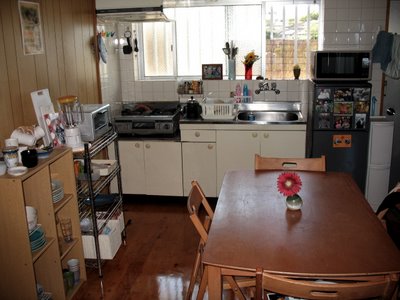Anyway, after that Sensei gathered up a gaggle of teachers to help us move all of Lisa's furniture to my new apartment. Anything requiring group effort is sugoi in Japan. Now the apartment is very homey.
 It's incredibly spacious for a Japanese apartment. Usually a family of 4 would live in 3 rooms. I have a kitchen, a 6-mat tatami room, and a living room. If you can visualize, the back wall of the 2 latter rooms is glass sliding doors that open out onto a balcony. I can see the ocean from my balcony, but it's a bit distant. Basically, there's a highway and a small field between us. But this doesn't stop me getting a good view of the sunset over the water, or the fireworks that Japanese people seems to like to set off for all occasions.
It's incredibly spacious for a Japanese apartment. Usually a family of 4 would live in 3 rooms. I have a kitchen, a 6-mat tatami room, and a living room. If you can visualize, the back wall of the 2 latter rooms is glass sliding doors that open out onto a balcony. I can see the ocean from my balcony, but it's a bit distant. Basically, there's a highway and a small field between us. But this doesn't stop me getting a good view of the sunset over the water, or the fireworks that Japanese people seems to like to set off for all occasions. 
The coolest thing about Japanese houses is that they're kind of like Transformers. You think you have a 3 room house, but actually ALL the inner walls of the house are mobile; so I can make my house 2 room, 3 room, or 1 room. The walls are formed of multiple sliding doors (yes, visualize the Last Samurai and you've got it). I don't have to walk out of the way to a "door" no no, instead, I just make a door where ever I want. It's like being able to walk through walls! Almost.
You may be a bit vague on tatami. Tatami is a special Japanese grass. Usually, apartments have at least 1 tatami room, which just means that the floor is made of thick, woven tatami mats. In fact, room dimensions in Japan are measured in "tatami mats" since there are standard sizes, instead of square feet. I think traditionally people do specific things in tatami rooms, but people seem to sleep in them nowadays. Or eat with guests, at those low laying tables that you have to kneel for. Every time a new renter moves into an apartment, fresh tatami is laid. So my mats are still green, and fragrant. Whether or not you like the smell of tatami might make a significant difference in your life. I like the smell, so I'm all set. It rolls over me everytime I open the front door.

No comments:
Post a Comment